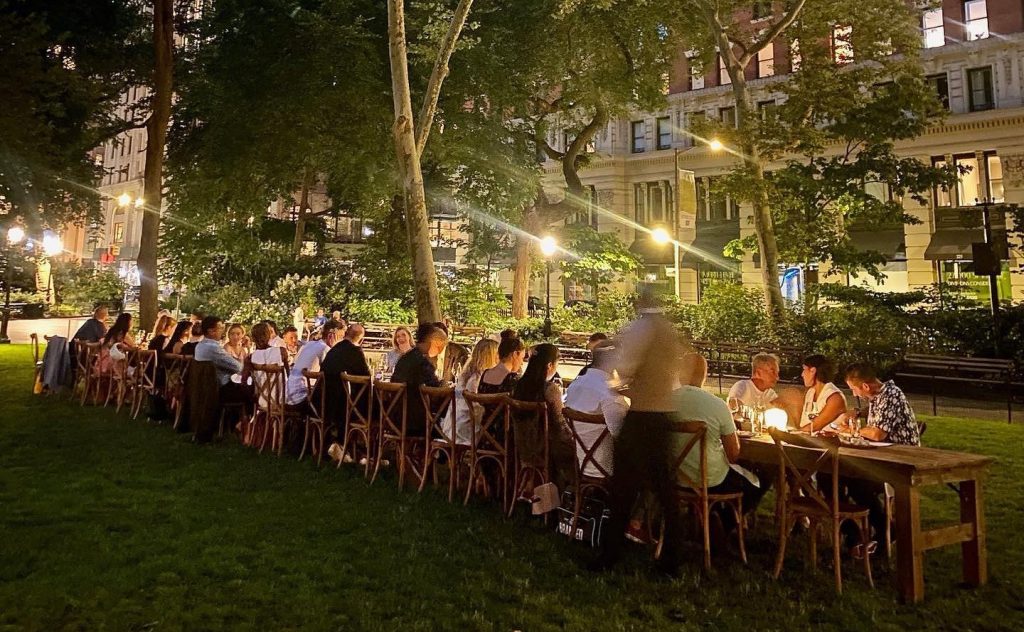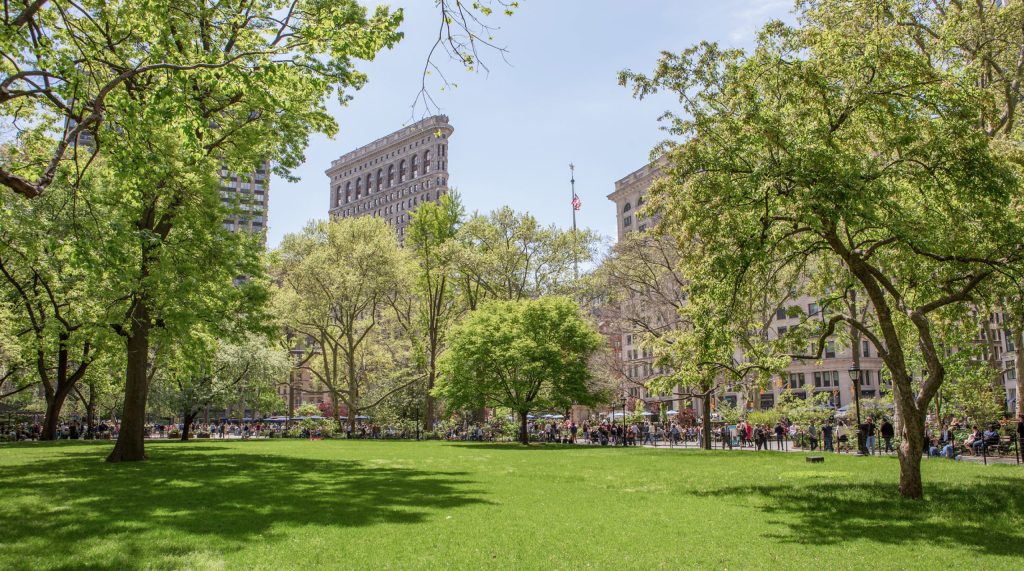मैडिसन स्क्वायर पार्क कंज़र्वेंसी के साथ जलवायु-सचेत खाद्य सेवा को प्रेरित करना

मैडिसन स्क्वायर पार्क कंज़र्वेंसी (एमएसपीसी), एक गैर-लाभकारी संस्था जो न्यूयॉर्क शहर के हृदय में स्थित 6.2 एकड़ के हरित क्षेत्र की देखभाल के लिए जिम्मेदार है, जो इसका नाम साझा करती है, यह अपने पार्क के पारिस्थितिकी तंत्र को पोषित करने के साथ-साथ कार्बन उत्सर्जन को कम करने और अपशिष्ट और उपभोग में कमी के संबंध में सामुदायिक नेतृत्व प्रदान करने के लिए समर्पित है।
मैनहट्टन के फ्लैटिरॉन और नोमैड जिलों में स्थित इस पार्क में प्रतिदिन लगभग 60,000 आगंतुक आते हैं।
अपने दुर्लभ हैमामेलिस संग्रह (विच हेज़ल वृक्ष) के लिए लोकप्रिय, MSPC न केवल आगंतुकों के लिए एक हरा-भरा नखलिस्तान प्रदान करने के लिए, बल्कि पार्क और बड़े समुदाय के भीतर विशिष्ट संग्रहों के सकारात्मक प्रभावों के बारे में जनता को शिक्षित करने के लिए विभिन्न प्रकार की पौधों की प्रजातियों को शामिल करने के लिए समर्पित है। पार्क में विभिन्न जलवायु कला कार्यक्रम और प्रदर्शनियाँ भी आयोजित की जाती हैं, जिनमें से कई टिकाऊ सामग्रियों से बनाई जाती हैं और जलवायु के अनुकूल कार्यों पर ध्यान केंद्रित करती हैं। MSPC का आउटरीच यह सुनिश्चित करने के लिए आगे बढ़ता है कि उनके संरक्षण प्रयास केवल पार्क की सीमाओं तक ही सीमित न रहें, बल्कि समुदाय तक भी फैलें।

ग्रीन डाइनिंग डेस्टिनेशन
मैडिसन स्क्वायर पार्क कंज़र्वेंसी 2020 से आसपास के NYC रेस्तरां के साथ साझेदारी कर रही है ताकि अपने पड़ोस को एक नामित "ग्रीन डाइनिंग डेस्टिनेशनग्रीन डाइनिंग डेस्टिनेशन की विशेषता कुल 20 स्थानीय रेस्तराँ हैं जो सामूहिक रूप से साइन-अप करते हैं और ग्रीन रेस्तराँ एसोसिएशन (GRA) द्वारा निर्धारित विशिष्ट आवश्यकताओं को पूरा करते हैं ताकि वे "ग्रीन सर्टिफाइड" बन सकें। जैसा कि GRA की वेबसाइट पर बताया गया है, "प्रमाणन के लिए आवश्यक है कि रेस्तराँ अपने पर्यावरणीय प्रभावों को कम करने के लिए ठोस कदम उठाएँ, और इसमें एकल-उपयोग वाली वस्तुओं को खत्म करना, खाद्य अपशिष्ट को खाद बनाना और ऊर्जा उपयोग को कम करना जैसे कार्य शामिल हैं।"
फ्लैटिरॉन नोमैड पार्टनरशिप के माध्यम से, MSPC स्थानीय रेस्तराओं से जुड़ने में सक्षम है। मैडिसन स्क्वायर पार्क कंज़र्वेंसी में वरिष्ठ संधारणीयता प्रबंधक एमिली डिकिंसन ने स्थानीय समुदाय को आउटरीच अभियान की प्रक्रिया साझा की: "हम एक मार्केटिंग पैकेट साझा करके शुरू करते हैं जिसमें शामिल होने से रेस्तराओं को मिलने वाले लाभ शामिल होते हैं। हम रेस्तराँ मालिकों या प्रबंधकों को हमारे साथ आमने-सामने मिलने के लिए आमंत्रित करते हैं ताकि समुदाय पर पड़ने वाले प्रभाव पर ज़ोर दिया जा सके और अधिक जानकारी प्राप्त की जा सके, और सूचना सत्र आयोजित किए गए हैं।" एमिली बताती हैं कि रेस्तराँ मालिक प्रमाणन मानकों की समीक्षा करने और प्रमाणन की प्रक्रिया शुरू करने के लिए GRA से मिलते हैं।
लेकिन रेस्तरां के लिए प्रमाणन से वास्तव में क्या लाभ प्राप्त हुए हैं? कुछ नाम हैं: कार्बन फुटप्रिंट में कमी, अपशिष्ट, पानी और ऊर्जा के उपयोग में कमी, संबंधित लागतों में कमी, सामुदायिक कार्यक्रमों और सामग्रियों में उनके प्रयासों को प्रदर्शित करने के लिए शामिल होना, और पर्यावरण के प्रति जागरूक ग्राहक आधार में वृद्धि। MSPC और रेस्तरां के बीच संबंध प्रमाणन प्रक्रिया से परे भी जारी रहता है क्योंकि MSPC और फ़्लैटिरॉन नोमैड दोनों अपने समुदाय की सेवा के लिए कार्यक्रम और आयोजन आयोजित करते हैं। एमिली ने नोट किया कि सभी रेस्तरां का कार्यक्रम में स्वागत है: "शाकाहारी टैको ट्रक से लेकर स्टीकहाउस तक कोई भी रेस्तरां प्रमाणित होने के लिए अर्हता प्राप्त कर सकता है।"
ग्रीन प्रमाणित बनना
ग्रीन सर्टिफाइड बनने के लिए कुछ विशेष कदम उठाने होते हैं प्रमाणन मानक जीआरए द्वारा निर्धारित श्रेणियों में विभाजित ऊर्जा, पानी, बरबाद करना, पुन: प्रयोज्य और डिस्पोजेबल, रसायन एवं प्रदूषण, खाना, भवन एवं साज-सज्जा, और शिक्षा और पारदर्शिता. . 4 प्रमाणन स्तर हैं, जिन्हें एक से चार सितारा रेटिंग प्रणाली द्वारा परिभाषित किया गया है, जो विशिष्ट कार्यों के लिए अंकों के संचय पर आधारित है। इस विखंडन का चार्ट नीचे देखा जा सकता है। GRA मानकों का उद्देश्य प्रत्येक रेस्तरां की व्यक्तिगत उपलब्धियों के लिए एक पारदर्शी उपाय के रूप में कार्य करना है, साथ ही यह मापना भी है कि वे अपने संधारणीय प्रथाओं को बेहतर बनाने के लिए क्या अतिरिक्त कदम उठा सकते हैं। उम्मीदवार के लिए एक या अधिक उत्सव बैज प्राप्त करना भी संभव है, जिसमें शामिल हैं लगभग शून्य अपशिष्ट, स्वच्छ रसायन, शाकाहारी, शाकाहारी, टिकाऊ समुद्री भोजन, या सस्टेनाबिल्डटीएम.

मानकों का गहन अध्ययन
The ऊर्जा मानक हीटिंग/कूलिंग/वेंटिलेशन, वॉटर हीटिंग, लाइटिंग, किचन इक्विपमेंट-कुकिंग, किचन इक्विपमेंट-रेफ्रिजरेशन, वार्षिक रखरखाव, विविध, ऑन-साइट बिजली उत्पादन और अक्षय ऊर्जा क्रेडिट की श्रेणियों में विभाजित है। इस मानक में अर्जित अंक 1 (स्टॉर्म विंडो, सीलिंग फैन और इंफ्रारेड चारब्रॉयलर जैसी विशेषताओं के लिए) से लेकर 380 (ऑन-साइट अक्षय बिजली उत्पादन/सौर, पवन के लिए) तक होते हैं।
The जल मानक इसे रीसाइकिलिंग, अपशिष्ट न्यूनीकरण, खाद्य अपशिष्ट डायवर्जन, खाद्य अपशिष्ट न्यूनीकरण और शिक्षा एवं प्रशिक्षण की श्रेणियों में विभाजित किया गया है। इस मानक में अर्जित अंक 1 (उच्च दक्षता वाले मूत्रालय, दोहरे फ्लश शौचालय और वर्षा उद्यान जैसी विशेषताओं के लिए) से लेकर 17.5 (पानी रहित वोक के लिए) तक होते हैं।
The अपशिष्ट मानक लैंडस्केपिंग, रसोई, शौचालय और अन्य श्रेणियों में विभाजित किया गया है। इस मानक में अर्जित अंक 0.5 (डबल-साइड प्रिंटर, फर्नीचर दान और थोक पैकेजिंग जैसी विशेषताओं के लिए) से लेकर 20 (पशु भोजन के रूप में पुन: उपयोग किए जाने वाले खाद्य अपशिष्ट के लिए) तक होते हैं।
The पुन: प्रयोज्य और डिस्पोजेबल मानक इसे सीमित डिस्पोजेबल अपशिष्ट, पुनः प्रयोज्य, पेपर डिस्पोजेबल और पुनः प्रयोज्य विकल्प, अतिरिक्त डिस्पोजेबल और पुनः प्रयोज्य विकल्प, तथा बंद लूप अपशिष्ट स्ट्रीम में कंपोस्टेबल डिस्पोजेबल की श्रेणियों में विभाजित किया गया है। इस मानक में अर्जित अंक 0.25 (पुनः भरे या पुनर्चक्रित स्याही कारतूस, 100% कुल पुनर्चक्रित सामग्री से बने डिस्पोजेबल, और ब्लीचिंग आवश्यकता को पूरा करने वाले डिस्पोजेबल जैसी विशेषताओं के लिए उच्चतम पात्र स्तर के ग्रीनपॉइंट्स™ अर्जित करते हैं) से लेकर 100 (FOH आइटम के लिए फास्ट कैजुअल/फास्ट फूड 100% पुनः प्रयोज्य) तक होते हैं।
The रसायन एवं प्रदूषण मानक साइट चयन, स्टॉर्मवॉटर प्रबंधन, प्रकाश प्रदूषण, परिवहन और पेट्रोलियम न्यूनीकरण, रासायनिक न्यूनीकरण, कीट प्रबंधन और रसायनों की श्रेणियों में विभाजित किया गया है। इस मानक में अर्जित अंक 0.5 (बस लाइन से ¼ मील की दूरी पर स्थित इमारतों, साइट पर शॉवर होने और ¼ मील दूर स्थित स्कूटर स्टेशन जैसी विशेषताओं के लिए) से लेकर 25 (ब्राउनफील्ड पुनर्विकास के लिए) तक होते हैं।
The खाद्य मानक शाकाहारी और शाकाहारी मेनू विकल्प, स्थानीय भोजन, संधारणीय समुद्री भोजन और संधारणीय भोजन और पेय की श्रेणियों में विभाजित है। इस मानक में अर्जित अंक 1 (साइट पर उगाई गई हरी सब्ज़ियाँ/जड़ी-बूटियाँ, 300 मील के भीतर प्राप्त स्थानीय भोजन और USDA प्रमाणित जैविक खाद्य पदार्थ) से लेकर 100 (शाकाहारी मुख्य व्यंजनों और खाद्य पदार्थों के प्रतिशत के लिए) तक होते हैं।
The भवन एवं साज-सज्जा मानक इसे फर्निशिंग, फैब्रिक और मर्चेंडाइज, कोटिंग्स और एडहेसिव्स, इंटीरियर बिल्डिंग मटीरियल और कंस्ट्रक्शन आइटम की श्रेणियों में विभाजित किया गया है। इस मानक में अर्जित अंक 1 (50% तक के पुनर्चक्रित पेंट और कोटिंग जैसी विशेषता के लिए) से लेकर 8 (पुनः उपयोग किए गए या बचाए गए फर्नीचर, स्टाफ़ के परिधान और मर्चेंडाइज के लिए) तक होते हैं।
The शिक्षा और पारदर्शिता मानक शिक्षा और पारदर्शिता की श्रेणियों में विभाजित किया गया है। इस मानक में अर्जित अंक 0.5 (प्रमाणन या पुनःप्रमाणन के बारे में सोशल मीडिया पर पोस्ट करने जैसी विशेषता के लिए) से लेकर 5 (90% स्टाफ सदस्यों के ग्रीन रेस्टोरेंट मान्यता प्राप्त कर्मचारी होने के लिए) तक होते हैं।
एमएसपीसी के साथ ग्रीन प्रमाणित कौन हुआ है?
आज तक, एमएसपीसी ने नौ रेस्तरां को प्रमाणन प्राप्त करने में मदद की है: स्कार्पेटा, बारकेड, हनीब्रेन्स, ब्लैकबार्न, रेज़डोरा ओस्टेरिया एमिलियाना, हॉक्समूर, अमेरिकन कट, बॉम्बे सैंडविच कंपनी, और शेक शेक साथ तरालुची ई विनो उन्हें प्रमाणीकरण के मार्ग पर सूचीबद्ध किया जा रहा है।

टेकअवे और अगले कदम
ग्रीन रेस्टोरेंट एसोसिएशन के सीईओ और संस्थापक माइकल ओशमैन ने कहा, "'यह महत्वपूर्ण है कि हम इस उद्योग को पर्यावरण की दृष्टि से टिकाऊ बनाने के लिए इन सभी श्रेणियों को संबोधित करें,' ओशमैन ने कहा। 'मुख्य बात जो गायब है, वह यह है कि इन मुद्दों को अभी संबोधित करना कितना महत्वपूर्ण है, इसकी तीव्र भावना है। रोमांचक खबर यह है कि हमें भविष्य की किसी तकनीक का इंतजार करने की जरूरत नहीं है। हम अभी से रेस्टोरेंट की मदद कर रहे हैं।'"
अपशिष्ट और उत्सर्जन को कम करने के लिए रेस्तरां और विक्रेताओं के साथ काम करने के लिए सबसे पहले अपने आस-पास के रेस्तरां और अन्य खाद्य विक्रेताओं से संपर्क करना महत्वपूर्ण है। साथ में, आप फिर काम करने के लिए लक्ष्य निर्धारित कर सकते हैं। यह ध्यान दिया जाता है कि किसी भी लक्ष्य को प्राप्त करने के लिए रेस्तरां की दैनिक दिनचर्या में स्थिरता प्रथाओं का कार्यान्वयन आवश्यक है। एकल-उपयोग अपशिष्ट को कम करना, खाद बनाना और स्थानीय खरीदना कुछ ऐसे विचार हैं जिनसे सही तरीके से शुरुआत की जा सकती है!
यदि आप एक क्लाइमेट टूलकिट संस्था हैं जो उत्सर्जन और अपशिष्ट को कम करने के लिए विक्रेताओं के साथ काम करने में रुचि रखते हैं, तो कृपया एमिली डिकिंसन से संपर्क करें edickinson@madisonsquarepark.org. अतिरिक्त जानकारी यहां पाई जा सकती है यहाँ और फ्लैटिरॉन नोमैड में पूर्ण विपणन सारांश योजना.

सूत्रों का कहना है:
- https://madisonsquarepark.org/
- https://madisonsquarepark.org/park/conservancy/
- https://madisonsquarepark.org/community/news/2022/08/transforming-the-neighborhood-into-nycs-first-green-dining-destination/
- https://www.dinegreen.com/certification-standards
- https://flatironnomad.nyc/wp-content/uploads/2023/02/FN-MSPC-Green-Dining-Destination-Marketing-Summary.pdf






हाल ही की टिप्पणियाँ